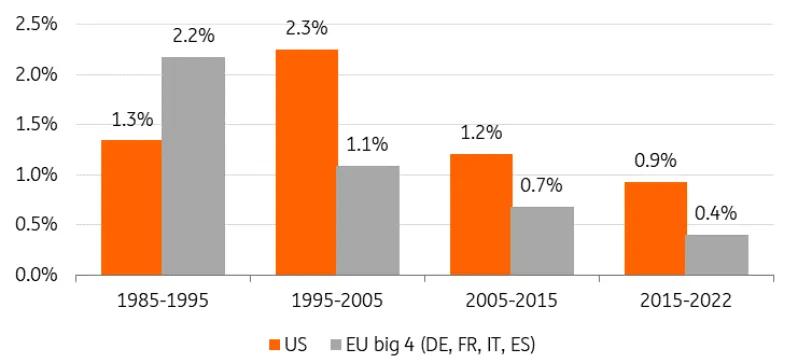
AI productivity gains may be smaller than you’re expecting
12 April 2024
Reading time: 3 min
Much is made of Artificial Intelligence’s potential to transform labour markets and make productivity gains. But at a macro level, we think those AI productivity gains, while significant, may not be quite so spectacular.
Artificial Intelligence is discussed not only as a potential source of radically transforming labour markets but also as something that could bring about major productivity gains. And not just for specific companies or sectors but for the Opens in a new tabeconomy as a whole. According to some, the technology is so revolutionary that it could lead to a positive productivity shock, capable of creating stronger economic growth. So, is this just a sci-fi movie plotline, or could it be an economic reality? Just what sort of productivity gains can we expect from AI at the macroeconomic level?
AI’s impact has yet to show in country-level data
Despite the increasing adoption of AI and other technological advancements over the last decade, productivity growth in many developed economies has been relatively slow in recent years. The current absence of a big AI impact on country-level productivity figures does not mean, however, that there will be no impact at all. In fact, it is simply too early for the impact to already be felt in aggregate figures. The delayed impact of technological innovations on productivity is not unique to AI. Electricity was introduced at the end of the 19th century, but its impact on productivity only materialised after the First World War. The same is true with the developments of the internet and personal computers in the early 80s, when Solow made his famous quip about computers and productivity, namely that "the computer age is visible everywhere, except in productivity statistics". Indeed, it seems that we are once again faced with Solow's paradox (1987).
Average annual growth of labour productivity

Real GDP per hour worked
A latent productivity effect
In 1987, many believed the computer had merely yielded a transformation of work but had not increased productivity; the productivity effect would follow much later. From 1995 to 2005, productivity grew at a much higher rate in the US than in previous years (2.3% per year on average between 1995 and 2005 versus 1.3% during the decade before). Both in the case of the invention of electricity and of the computer, a profound productivity boom started in the US about 20 years after the emergence of the new technology, at a point when roughly half of businesses had adopted the technology.
There was no such boom in Europe
It is interesting to note that there was no such boom in Europe, where productivity actually fell after 1995. Research shows that the decline in labour productivity growth resulted from both lower capital deepening - associated with the robust pace of job creation, and lower total factor productivity growth - which the higher utilisation of lower-skilled workers might partly explain. Moreover, the euro area economy seems to have benefited much less from increased production and use of ICT technologies, particularly in the services sector (Gomez-Salvador et al., 2006).
Read more about AI productivity gains on Opens in a new tabING THINK
Authors
Senior Economist, France and Switzerland
Charlotte de Montpellier

Senior Economist ING Deutschland
Inga Fechner
